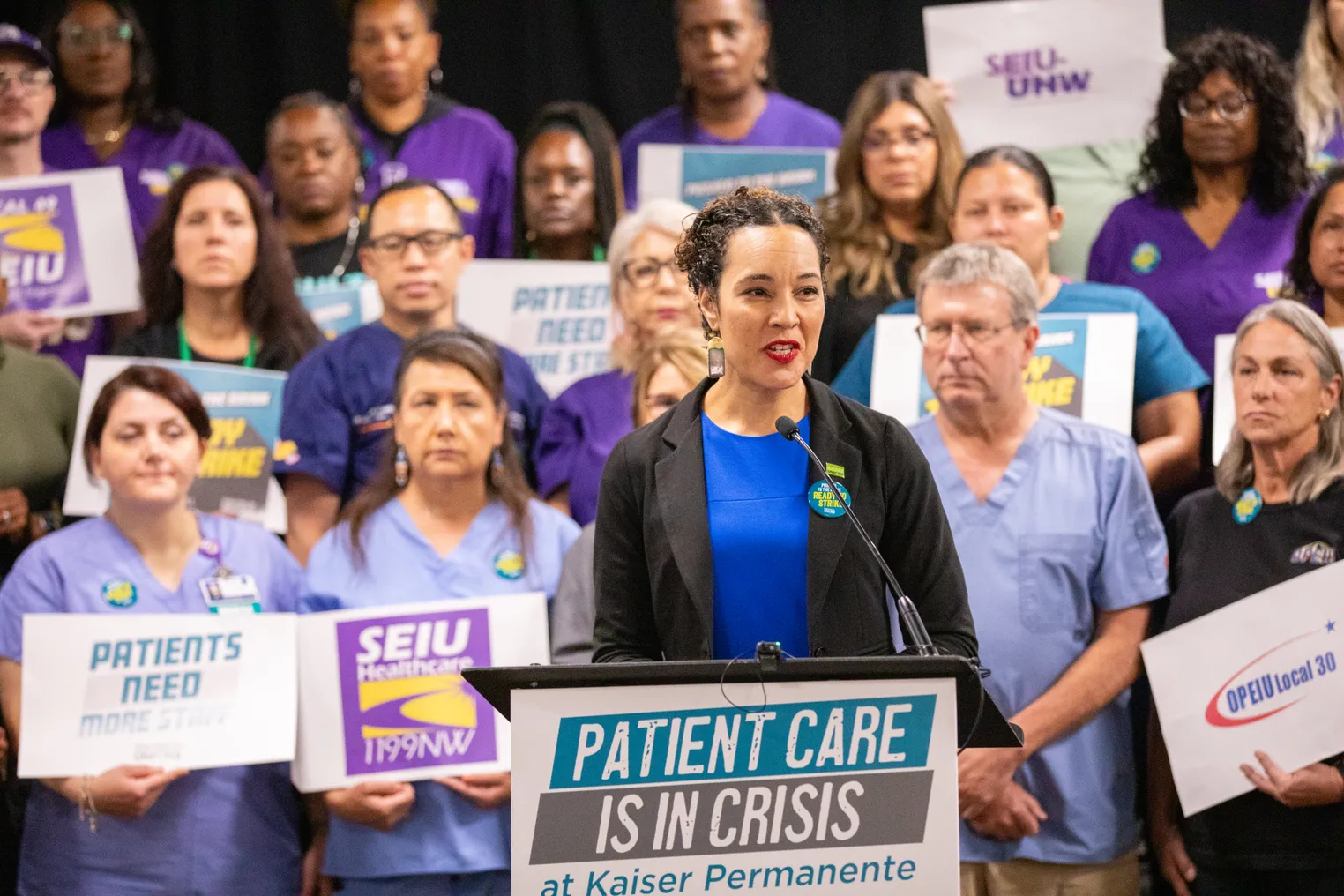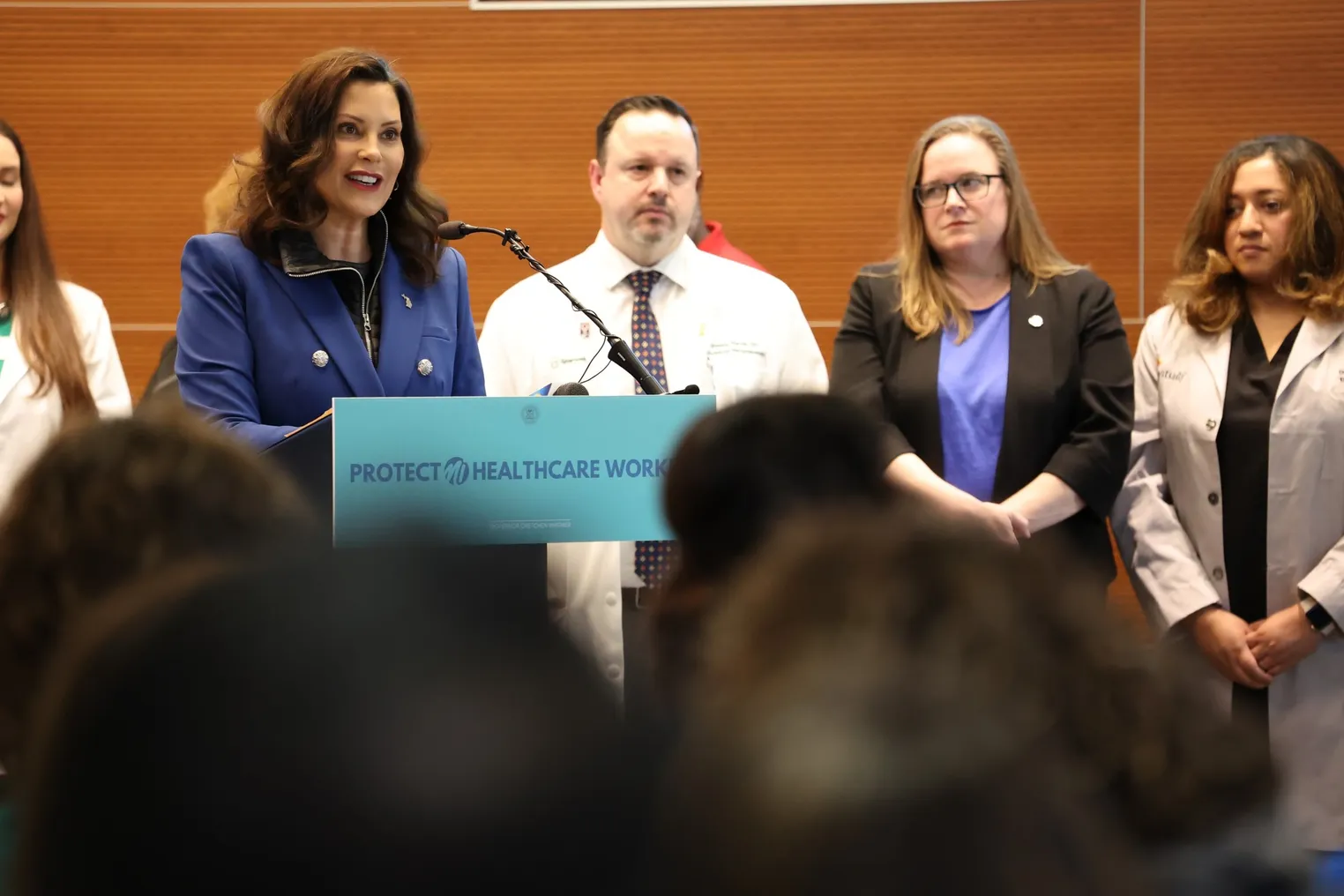
Where are all the nurses? Hospitals, advocates disagree on crisis
If you ask nurses and hospital administrators about the state of nurse staffing, both will tell you that there are not enough nurses currently working the bedside.
But that’s about the only thing they can agree on.
From the cause of the problem, to how to fix it or what to name it — hospitals label it a “nursing shortage,” while unions and advocates call it a “safe staffing” failure — labor and management are at odds about the particulars of the nation’s staffing crisis.
Hospitals say they are doing their best to hire, but that there aren’t enough accredited nurses available. The American Hospital Association said it expected to lose half a million nurses by the end of 2022, creating a total shortage of 1.1 million nurses nationwide.
During an investor day presentation in Nov. 2023, HCA chief nurse executive Sammie Mosier said there was no doubt there was a nursing shortage. Hospital operators have been hoping for a reprieve to the so-called “labordemic” that they say has left them struggling to replace nurses lost to attrition.
But nurses unions bristle at calling the problem a shortage — and reject the idea that the staffing crisis is a new concern for the industry. They claim the term lets hospitals off the hook for their role in creating vacancies, and say any current shortage of nurses is the result of hospitals’ own decisions coming home to roost.
Tensions between the two sides boiled over in 2023, with demands for increased staffing driving strikes at hospital operators like Prime Healthcare, Robert Wood Johnson University Hospital and Ascension St. Joseph, among others.
“They don't own up to the fact that they have created [the shortages] with their practices,” said Margaret Franks, registered nurse and regional director for the New York Nurses Association. “It has been proven that it is not a nursing shortage, it is just a shortage of nurses willing to work in the conditions that are present at the bedside right now.”
Without first fixing the workplace problems in U.S. hospitals, Franks said that any nurse recruitment efforts are essentially building on quicksand — they may get people in the door, but they lack the foundation to succeed.
“We all have friends that have left nursing and they all say the same thing to us: We're not coming back. I'm not coming back to eight patients,” Franks said. “You can’t build up teams on bad foundations. They would rather take less money or work five days a week instead of three shifts where they can do their jobs properly.”
Data shows a pool of nurses, but hospitals are struggling to hire
The numbers present a paradox — the nursing talent pool is growing, and yet, it is getting harder for hospitals to hire.
The number of candidates passing the nurse licensure exam grows each year, according to the national nursing licensing agency. New nurses join a pool of 5.2 million registered nurses currently in the workforce as of 2022 — 89% of whom work in the industry, according to a national survey of nurses conducted biannually by the National Council of State Boards of Nursing (NCSBN) and the National Forum of State Nursing Workforce Centers.
At the same time, there are more job postings for nursing positions in 2023 compared to 2020, said Julia Pollak, chief economist at online recruiting platform ZipRecruiter.
For-profit hospitals are among employers desperate to hire. Executives at operators like HCA Healthcare, Tenet Healthcare and Community Health Systems have reported paying hefty rates for temporary contract nurses since the onset of the pandemic, leading nursing recruitment to become a top priority.
And yet, nursing positions at hospitals go unfilled as the number of interested applicants dwindles compared to years past.
On ZipRecruiter, applications for nursing positions have fallen 11%in 2023 compared to 2022. Companies are also having to work harder for each application, ZipRecruiter’s Pollak said. In order to generate a single “quality applicant,” an average of nine individuals must view a job posting — in 2022, that number was only five.
Outside of online job boards, data from The U.S. Bureau of Labor Statistics, which produces monthly jobs data to track job openings and turnover, confirms that recruiting nurses is becoming more of a slog.
Prior to the pandemic, it took less than two months to fill a healthcare job on average during the latter months of 2019, as calculated as the inverse of the ratio of hires to job openings. The time to fill healthcare positions rose to 2.2 months in Sept. 2023, according to the most recent data available from the BLS.
Difficulty hiring persists even as healthcare companies have started raising salaries, offering signing and relocation bonuses, tuition reimbursement and payment for training, Pollak said.
Hospital employees’ average hourly earnings growth approached 3.8% in July 2023, above the 2.3% average growth reported between 2010 to 2019, according to credit agency Fitch Ratings.
But, despite pulling out “all the stops,” efforts largely haven’t paid off, according to Pollak.
“Health organizations have done a huge amount of work to get more engagement on their postings,” Pollak said. “The problem is, this is not a labor shortage that is just solvable through pay.”
Why are hospitals failing to attract nurses?
Though there are millions of registered nurses in the talent pool, there are also more quitting, experts said.
More than 100,000 left the profession in 2021 after the pandemic caused workplace conditions to deteriorate, according to a study published in Health Affairs. The researchers said it was a “far greater drop than ever observed over the past four decades.”
Nurses who quit the profession told consulting firm McKinsey in 2023 that they left because they felt under valued, inadequately compensated, and unable to manage increasingly intense workloads.
Almost half of respondents in the McKinsey survey said an unsafe working environment impacted their decision to exit direct patient care, an increase of 24% from the prior year.
Labor conditions inside hospitals have grown more precarious over recent years, with nurses facing increasing on-the-job violence, injuries and illness, according to industry data and experts.
Nurses who remain struggle with rising rates of burnout as they shoulder the workloads of short-staffed units, according to a study conducted by the University of Pennsylvania School of Nursing’s Center for Health Outcomes and Policy Research. The problem is cyclical, studies suggest, as burned out nurses are more likely to look elsewhere for a job.
“Workers are changing. They care more about work life balance now. And, ironically, the shortages of staff have actually made healthcare roles less attractive... and made people have to work crazier hours,” Pollak said. “And so we're seeing physician burnout has reached crisis levels, and there are many people who are leaving long before they otherwise would have.”
That includes nurses who choose to retire early, according to Therese Fitzpatrick, senior vice president of healthcare management consulting firm Kaufman Hall’s performance improvement practice.
Poor working conditions at hospitals, such as inflexible 12-hour shifts, are driving senior nurses from the bedside, she said.
The churn of more seasoned workers has down-stream impacts.
With a shortage of senior workers, it’s more difficult for junior nurses to receive proper training, said New York Nurses Association’s Franks. She serves as a precept, or trainer for junior nurses, at Vassar Brothers Medical Center, a 349-bed facility that serves the Hudson Valley in New York.
Franks said that Vassar has hired 123 nurses since the start of 2023, but 93 have already left due to inadequate training.
“The issue is not in recruiting. It's actually retaining once those nurses come in,” she said. “Obviously they're coming in. We have new nurses graduating, usually twice a year in May and December.”
With training costs approximately $88,000 per nurse, Franks said the hospital is burning money when so many nurses quit prior to completing their training.
“That’s $8 million that walked right out the door alone this year,” she said.
Nurses are looking elsewhere for work
Increasingly, hospitals have to compete with non-traditional employers for nursing talent — ranging from retailers like Home Depot, CVS Health and Walgreens to start-ups. These companies are attractive because they can offer nine-to-five schedules and less stress compared to hospitals, Pollak said.
One nurse who left her hospital job to work at a non-traditional employer is Sarah Lacy. She quit her job in 2020 to work as a registered nurse in an ear piercing studio.
The New York City-based piercing studio, called Rowan, competes with hospitals for jobs and exclusively hires nurses to pierce ears.
The job gives nurses an opportunity to apply their medical skills without the “verbal abuse and physical abuse” that some nurses experience in the emergency room, Lacy said.

“When I first joined Rowan, I had no intention of leaving the hospital. At the time, it was a part time job, and I thought it would be a really fun way to get to use my nursing skills in a situation that is not stressful, like the way bedside nursing is,” Lacy said.
However, as she logged more hours at Rowan, Lacy came around to the idea of working full-time, piercing ears and training new nurses at Rowan. She said the biggest draw was the environment — studios were clean, people came to see her at some of their happiest moments and she got to apply her clinical expertise.
“I don't know what would be enough to draw me back to the bedside after this,” Lacy said. “As nurses, we have that innate desire to help people and to make a difference in people's lives. It’s transformational when you get to do that in a way that is so fun.
“I really don't want to go back, if I'm being honest,” she said.
How hospitals can win nurses back
Although hospitals are struggling to hire and retain nurses, it’s not an impossible task, according to Pat Brown, EVP of human resources at Northwell Health.
Northwell, the largest health system in New York, operates 21 hospitals and had an average of 900 open RN positions in Nov. 2023 — roughly the same number it did in 2019.
According to Brown, the health system boasted a turnover rate during the pandemic that was half the national average and kept stable staff through this year due to investments in recruitment and retention.
The hospital system has a network of almost 200 nursing programs. Northwell sends representatives to nursing career expos and even has a presence on TikTok.
Still, “The [nursing] supply is definitely constrained,” Brown said.
Other hospitals may benefit from similar strategies to recruit and retain staff, including partnering with nursing schools, offering virtual nursing roles that are less demanding, shorter shift options and “phased retirement” for older nurses, said Kaufman Hall’s Fitzpatrick.
“Organizations are essentially growing their own [nurses], and are willing to make that investment, because when you think about the impact long term, it makes financial sense,” Fitzpatrick said. “It could have a significant ROI when you look at balancing the upfront cost against the cost of contract labor.”
The strongest signal of an investment in nurses, according to nurses unions, is implementing nurse-to-patient ratios, which cap how many patients a nurse can care for at a given time.
Ratios can signal to nurses that hospitals are serious about patient welfare and workplace safety, said Debbie White, president of New Jersey-based nurse union Health Professionals and Allied Employees.
In 2023, White appeared alongside Sen. Bernie Sanders, I-Vt., at a field Senate Health, Education, Labor and Pensions (HELP) Committee in New Jersey to argue the benefits of fixed patient-to-staff ratios. She told Healthcare Dive that ratios might not bring back the Sarah Lacys of the world who have contentedly left the profession — but they could help stop the bleeding.
“I'm not telling anybody that nurses will come back to the bedside,” White said. “What I will promise you is that nurses will stop leaving hospitals. And if we fix that problem, we will retain staff. That is when we fix the profession.”
iStock.com/PeopleImages
















